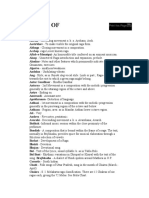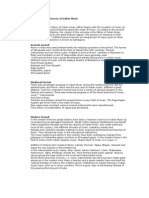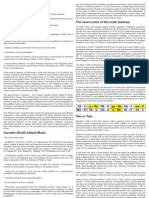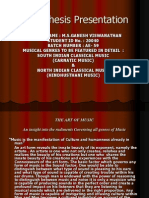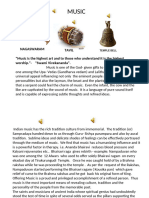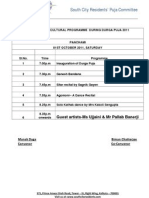Carnatic Classical Music Course Description
Carnatic Classical Music Course Description
Uploaded by
abhijithjCopyright:
Available Formats
Carnatic Classical Music Course Description
Carnatic Classical Music Course Description
Uploaded by
abhijithjCopyright
Available Formats
Share this document
Did you find this document useful?
Is this content inappropriate?
Copyright:
Available Formats
Carnatic Classical Music Course Description
Carnatic Classical Music Course Description
Uploaded by
abhijithjCopyright:
Available Formats
South Indian Carnatic Classical Music course description by Mrs. Shobana Raghavan 212-537-6258 shobragh5@yahoo.
com Basic concepts in Carnatic music:- Importance of Shruthi (pitch) Panchama shruthi(tonic and perfect fifth) and Madhyama shruthi( perfect fourth as tonic) and Laya(rhythm) with swara(solfege) concepts with historical meaning, octave classifications called sthayi, basic talas(rhythmic cycles) popularly used, and introduction of carnatic music notes and its varieties. Voice range training and breathing methods:- Use of full voice and head voice in solfege training and breath control-akaara,ikaara,ukaara and makaara saadhakam How a Raga(Melodic scale) is formed:- Combinations of swaras, melakartha(mother raga) scheme, janya raga(child raga) concept, varieties possible in janya ragas varja(missing notes), upanga(belonging notes), bhashanga(alien notes) varieties. More details on raga:- Janya Ragas continued vakra(zig-zag), sampurna(wholesome) ragas, Number system(katapayadhi sankhya) followed in the melakartha scheme and its identification mechanism, Saptha Tala Scheme:- Rhythm varieties, concept of graha with examples, tala angas(parts of a talam), aksharas(tala counts), kaarvai(extension of note), gathi bedhas(transfer from one tala pattern to another within a basic tala variety) Solkattu training:- Clusters of intricate rhythmic beats called Solkattu are orally recited to add interest to a musical composition. Methods of writing Carnatic music:- Musical notation, symbols used , using written music notation to sing. Small important topics:- Gamaka(note oscillations), anuswara, jaaru(slide in notes), spuritham or briga, sahitya(lyrics), swarakshara, sangathi, kala pramaana(speed employed in a song) Structured Learning of Carnatic Music:- Swaravali, Jantai, Tara sthayi and Dhaatu varisaigal (swara lessons for practical singing), Alankaras( use of saptha talas in singing), Geetham(use of sahitya in a song), Swarajathi( concept of sollukattu or rhythmic syllables, meaning of jathi
and its use in a song), Varnam and its varieties, Kriti, Keerthana, Viruththam or Shloka. Composers in Carnatic music and scope for creativity:- The Trinity, Shri Purandaradasar hailed as the father of carnatic music learning, traditional and modern composers at a glance, creative concepts in carnatic music - alapana, neraval, kalpanaswaras, tanam, pallavi, grahabedha or shruthibedha. Instruments generally used for a concert and musical pattern followed:- Musical structure of a typical Carnatic music concert including thani aavartanam( solo by drummer or mridangam artiste), thukkadas, folk number, bhajan, concept of tillana and mangalam( concluding musical piece). Practice and performance:- Guru-sishya parampara(direct learning from teacher), sadhagam(hours of practice), concert listening techniques, how to become a performing carnatic music professional.
Each lecture session will have students repeating and singing swaras and ragas with the use of talas. Small assignments will be given for students to prepare, from topics covered in a particular session like - writing swara passages - creating a raga with a particular format - elaborating a raga with different combinations of swaras - recording a musical phrase and playing it during the session - voice training and group singing - playing different talas and notating it. - composing musical pieces within the raga framework
You might also like
- Madhyama PrathamDocument29 pagesMadhyama Prathamvamsi67% (6)
- Hindustani Music SyllabusDocument3 pagesHindustani Music SyllabusJataveda BanerjeeNo ratings yet
- Vaisnava HarmoniumDocument141 pagesVaisnava HarmoniumBhn Vera83% (6)
- Publication On Voice Culture (Authored by ABshek) PDFDocument4 pagesPublication On Voice Culture (Authored by ABshek) PDFAnonymous w0UzyvNo ratings yet
- The Journey of the Sitar in Indian Classical Music: Origin, History, and Playing StylesFrom EverandThe Journey of the Sitar in Indian Classical Music: Origin, History, and Playing StylesRating: 5 out of 5 stars5/5 (1)
- Carnatic MusicDocument59 pagesCarnatic MusicPradeepKumarNo ratings yet
- Theory of Carnatic MusicDocument10 pagesTheory of Carnatic MusicSasi SNo ratings yet
- CarnaticMusicKnol Vs 082209Document3 pagesCarnaticMusicKnol Vs 082209ramkrishnapasalaNo ratings yet
- Know Carnatic MusicDocument74 pagesKnow Carnatic MusicAnikethRamesh100% (2)
- Terms of RagaDocument12 pagesTerms of RagaDaniel RosaNo ratings yet
- Comparison of RagasDocument5 pagesComparison of Ragassuriyaprakash100% (1)
- Know Carnatic MusicDocument74 pagesKnow Carnatic MusicRajeetha DineshNo ratings yet
- Lec-Dem: Indian Classical (Hindustani) Vocal Music: E-Mail: Phone: (714) 996-0010Document4 pagesLec-Dem: Indian Classical (Hindustani) Vocal Music: E-Mail: Phone: (714) 996-0010Shambhu KumarNo ratings yet
- Brief Historical Survey of Indian MusicDocument3 pagesBrief Historical Survey of Indian Musicapi-26894171100% (3)
- Carnatic Vocal Final CurriculumDocument13 pagesCarnatic Vocal Final CurriculumBlazewormNo ratings yet
- Carnatic Music DictionaryDocument11 pagesCarnatic Music DictionarySesh AmruthaSuryaNo ratings yet
- Indian Classical Music PDFDocument2 pagesIndian Classical Music PDFshagun1rastogiNo ratings yet
- Musictheory 3Document11 pagesMusictheory 3api-360662446100% (1)
- Art and Culture of IndiaDocument42 pagesArt and Culture of IndiaPriya Dixit100% (3)
- University Grants Commission Net Bureau: Subject: MUSIC Code No.: 16 SyllabusDocument21 pagesUniversity Grants Commission Net Bureau: Subject: MUSIC Code No.: 16 SyllabusAbhinav MishraNo ratings yet
- Carnatic Music - WikipediaDocument79 pagesCarnatic Music - WikipediaivanNo ratings yet
- Indian Art Music TalkDocument18 pagesIndian Art Music Talkpavan_padma977927No ratings yet
- Performing-Arts-Syllabus-2017-2018-Revised-2Document14 pagesPerforming-Arts-Syllabus-2017-2018-Revised-2Manoj MolagamudiNo ratings yet
- Theory VisharadPratham Paper1 Chapter3 NibaddhaGaanPrakaarDocument4 pagesTheory VisharadPratham Paper1 Chapter3 NibaddhaGaanPrakaarvenkatramananaghaNo ratings yet
- 06 Chapter 3Document30 pages06 Chapter 3Arnaud Didierjean0% (1)
- ShrutiDocument7 pagesShrutiBeejay Sibbaluca100% (1)
- The Two Styles: HindustaniDocument5 pagesThe Two Styles: HindustaniPampannagowda V PatilNo ratings yet
- #3-Study of Navarathri Krithis of Swathi TirunalDocument5 pages#3-Study of Navarathri Krithis of Swathi TirunalAnuradha MaheshNo ratings yet
- Divya Naama KeerthanaiDocument5 pagesDivya Naama Keerthanaisjo05100% (2)
- Indian MusicDocument8 pagesIndian MusicManinder JakharNo ratings yet
- An Introduction To Dhrupad Performance Platforms of India (#817841) - 1369021Document13 pagesAn Introduction To Dhrupad Performance Platforms of India (#817841) - 1369021Deepak KimolaNo ratings yet
- MusicDocument17 pagesMusicKumar AbhishekNo ratings yet
- Hindustani RagDocument61 pagesHindustani RagChintan Bhatt100% (3)
- VocalDocument14 pagesVocalsuntararaajanNo ratings yet
- Complete DocumentDocument19 pagesComplete DocumentpjetlpmefNo ratings yet
- GamakasDocument10 pagesGamakasshubham tiwariNo ratings yet
- Indian Art EnglishDocument20 pagesIndian Art Englishashutoshkashyap750No ratings yet
- Carnatic MusicDocument15 pagesCarnatic MusicbashraaNo ratings yet
- CarnaticDocument9 pagesCarnaticTamiltamil TamilNo ratings yet
- Carnatic Sangeet The South Indian System of MusicDocument7 pagesCarnatic Sangeet The South Indian System of MusicTanukuNo ratings yet
- CHAPTER 4 GR PHD EvrbDocument45 pagesCHAPTER 4 GR PHD EvrbDR.GANGA RAAMACHANDRANNo ratings yet
- Indian MusicDocument5 pagesIndian MusicRon 'shpatz' Cohen0% (1)
- Om Yakshraj Namastubhyam Shankar Priyah BandhavahDocument9 pagesOm Yakshraj Namastubhyam Shankar Priyah BandhavahmalikNo ratings yet
- Sapta Swaras - The Seven Musical Notes of Carnatic MusicDocument2 pagesSapta Swaras - The Seven Musical Notes of Carnatic MusicprashanthNo ratings yet
- Ragas and Talas Used in The SongsDocument26 pagesRagas and Talas Used in The SongsKarpagam Sangeetha VidyalayamNo ratings yet
- 14 - Chapter VIII PDFDocument44 pages14 - Chapter VIII PDFgsridharblr100% (1)
- "How Will I Map Sa Re Ga Ma ... " On Guitar?: Western's Note "C" Maps To Indian's Note "Sa"Document11 pages"How Will I Map Sa Re Ga Ma ... " On Guitar?: Western's Note "C" Maps To Indian's Note "Sa"Santosh PandeyNo ratings yet
- "How Will I Map Sa Re Ga Ma ... " On Guitar?: Western's Note "C" Maps To Indian's Note "Sa"Document11 pages"How Will I Map Sa Re Ga Ma ... " On Guitar?: Western's Note "C" Maps To Indian's Note "Sa"Santosh PandeyNo ratings yet
- Music Thesis PresentationDocument39 pagesMusic Thesis PresentationChunka OmarNo ratings yet
- Full Theory Hindustani VocalsDocument52 pagesFull Theory Hindustani VocalshetarthoNo ratings yet
- Articles by Dr. Gurnam SinghDocument57 pagesArticles by Dr. Gurnam SinghDr. Kamalroop SinghNo ratings yet
- MusicDocument17 pagesMusicandy.sara1212No ratings yet
- Raga Sangeet: Understanding Hindustani Classical Vocal MusicFrom EverandRaga Sangeet: Understanding Hindustani Classical Vocal MusicRating: 3.5 out of 5 stars3.5/5 (7)
- Sangeet Aarohee: An Essential Study of Hindustani Classical MusicFrom EverandSangeet Aarohee: An Essential Study of Hindustani Classical MusicRating: 5 out of 5 stars5/5 (3)
- Ankur - One - More Geoffrey Bawa Works 01Document22 pagesAnkur - One - More Geoffrey Bawa Works 01Neelam patelNo ratings yet
- Acculturation TheoryDocument5 pagesAcculturation Theoryfarabi nawarNo ratings yet
- Англи хэл 5-6Document5 pagesАнгли хэл 5-6Uranbileg GalbadrakhNo ratings yet
- South City Residents' Puja Committee: Guest Artists-Ms Ujjaini & MR Pallab BanerjiDocument5 pagesSouth City Residents' Puja Committee: Guest Artists-Ms Ujjaini & MR Pallab BanerjiimajumNo ratings yet
- Understanding Culture, Society and Politics Quiz #1Document3 pagesUnderstanding Culture, Society and Politics Quiz #1Score ExENo ratings yet
- EnglishDocument22 pagesEnglishShantanu100% (2)
- Programma Musica D'insieme Jazz Docente Roberto RossiDocument5 pagesProgramma Musica D'insieme Jazz Docente Roberto RossiNicholas TonnaNo ratings yet
- 72nd & ParkDocument64 pages72nd & ParkNone None None100% (1)
- How To Read and Type Chinese Characters On Your Computer andDocument5 pagesHow To Read and Type Chinese Characters On Your Computer andYoo YeoNo ratings yet
- Diaspora Films CulturesDocument4 pagesDiaspora Films CulturessammuNo ratings yet
- 1ST Quarter - 10 ArtsDocument7 pages1ST Quarter - 10 ArtsMylene Delantar Atregenio100% (1)
- Building Planning and DrawingDocument26 pagesBuilding Planning and Drawingmoondonoo7No ratings yet
- Ancient Wisdom Module III-Ancient Civilisation and Wisdom From Other Parts of The WorldDocument32 pagesAncient Wisdom Module III-Ancient Civilisation and Wisdom From Other Parts of The Worldrolex dilliNo ratings yet
- Teaching Guide: Ismat RiazDocument56 pagesTeaching Guide: Ismat RiazAbid GandapurNo ratings yet
- 1.a New Clue To Bosch's Garden of DelightsDocument4 pages1.a New Clue To Bosch's Garden of DelightsNika VanGoghNo ratings yet
- Controlling Microbial Growth in VitroDocument30 pagesControlling Microbial Growth in VitroJhon Lapuz100% (1)
- Questions For Final ExamDocument3 pagesQuestions For Final ExamAdelinaHoca100% (1)
- Measuring Culture by Lynn Watts PDFDocument27 pagesMeasuring Culture by Lynn Watts PDFManoj Varrier100% (1)
- Final ResearchDocument18 pagesFinal ResearchJean CancinoNo ratings yet
- Ar146 SP100 LizardoDocument3 pagesAr146 SP100 LizardoEd Drexel LizardoNo ratings yet
- Philippine Folk DancesDocument2 pagesPhilippine Folk DancesDennis Manaois100% (1)
- Timothy Leary - Space Migration SMIILE PDFDocument53 pagesTimothy Leary - Space Migration SMIILE PDFRichard Woolite100% (1)
- NADIA School ListDocument20 pagesNADIA School Listkumardasasim21No ratings yet
- Or Glory 21ST Century RockersDocument24 pagesOr Glory 21ST Century RockersJose Maria GomezNo ratings yet
- Indian Sexy Image PDFDocument3 pagesIndian Sexy Image PDFSalini Thapa25% (4)
- Islam in The West History and DevelopmentDocument19 pagesIslam in The West History and DevelopmentAime FarNo ratings yet
- United States Versus Foreign Business CulturesDocument4 pagesUnited States Versus Foreign Business Culturesdaleon jessaNo ratings yet
- Eastern Culture Vs Western CultureDocument2 pagesEastern Culture Vs Western CultureB-12 ESPEJO, Norman Rafael R. 11 STEM BNo ratings yet
- UCSP Module 3 Lecture NotesDocument8 pagesUCSP Module 3 Lecture NotescobalthansNo ratings yet
- Chapter Vi ActivityDocument5 pagesChapter Vi ActivityEly DaraugNo ratings yet









